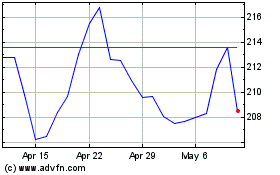The Markets Are Wild While You're Asleep
April 21 2020 - 6:29AM
Dow Jones News
By Gunjan Banerji
Trading in overnight stock futures has skyrocketed, adding to a
nearly nonstop stretch of market activity and luring more investors
to join in the action.
Among the most-traded are E-mini S&P 500 futures contracts,
whose overnight trading volumes have surged to a record this year,
according to CME Group Inc. data through March. Daily average
volumes have topped 500,000 contracts, more than double the number
recorded in 2017. The overnight session begins at 6 p.m. ET on
Sundays and weeknights and ends the following day at 9 a.m.
These are some of the most popular derivatives contracts among
investors, who often use them to hedge their portfolios or make
directional bets on the stock market. The S&P 500 is down 13%
in 2020.
The higher activity has helped amplify volatility in what has
been the most tumultuous period for investors in recent years. To
some analysts, it signals that markets around the world are more
interconnected than ever, with traders globally embracing
derivatives tied to major U.S. indexes as they trade around the
clock. Trading in these contracts also extends to the regular stock
trading session and concludes at 5 p.m.
Exchange operator CME has had a longstanding rule limiting price
swings in futures overnight to 5% up or down. On Sunday, March 8,
futures linked to the S&P 500 fell 5%, hitting limit-down, the
maximum drop allowed in a single session, for the first time since
the U.S. presidential election in 2016. The volatility hasn't let
up: Those stock futures have now hit limit-up or limit-down nine
times this year.
The wild swings have lured more traders looking for the
opportunity to profit in exchange for some sleepless nights.
Futures tied to the Dow Jones Industrial Average and the
tech-focused Nasdaq-100 index have been heavily traded as well.
Neel Shah, an options trader at Peak6 Capital Management, said
he started ramping up bets in the overnight market in late February
when market turbulence surged. By then, worries about the
coronavirus spreading around the globe had sparked a sharp selloff
in the stock market. On Feb. 28, U.S. stocks finished what was then
the worst week since the global financial crisis -- and the big
moves were extending to the overnight session.
"Now there isn't just one trading day," Mr. Shah said. "There's
multiple trading days in a 24-hour period."
He says he typically holds on to big options positions overnight
and puts out offers to buy or sell futures in the overnight
session. He gets automated alerts on his phone and computer that
tell him when a buyer or seller has taken him up on a trade.
Mr. Shah said he has "definitely lost a lot of sleep over the
last couple weeks."
Futures linked to the S&P 500 are tapped by big asset
managers, hedge funds and other traders around the globe. Despite
the increased interest, several analysts said it can be harder to
get in and out of positions overnight, leading to bigger
swings.
"They don't have as much liquidity," said Stino Milito, co-chief
operating officer at brokerage Dash Financial Technologies. "Which
is probably why you see the futures banging around so much."
Some analysts have said declining liquidity in the market for
E-mini S&P 500 futures during the latest market selloff also
exacerbated volatility in the broader stock market.
In one measure of the dramatic moves overnight, investing in the
biggest S&P 500 exchange-traded fund at the closing price and
selling at the opening price the next morning would yield about a
21% negative return this year, according to Dow Jones Market Data.
On the other hand, buying at the opening price and selling at the
end of the day would generate a positive 8% return.
Big exchange operators have taken steps to cater to the interest
in trading around the clock in recent years. Cboe Global Markets
Inc. extended trading in options on the Cboe Volatility Index, or
VIX, and S&P 500 index from 3 a.m. to 9:15 a.m. on weekdays in
2015.
It also started disseminating values every 15 seconds overnight
for the VIX index, a gauge of expected market swings, in April
2016. Arianne Criqui, Cboe's head of derivatives and global client
services, said there has been an uptick in individual investors
looking to trade futures tied to the VIX in places including Taiwan
and Australia.
The result: Few hours of the week are completely devoid of
trading activity.
Mr. Milito's firm has enlisted an extra trader to work overnight
and take orders for clients. Now two traders arrive around 2:30
a.m. ET, before the overnight S&P 500 and VIX options market
kicks off.
The resurgence in volatility has also drawn market watchers
eager to see how the futures market will react to the latest bit of
news on the economy. Outside of regular stock-trading hours -- 9:30
a.m. to 4 p.m. -- news from the White House and the Federal Reserve
and updates on the pandemic's spread around the world often draw
swift moves in the futures market.
Dash's Mr. Milito said he recently started watching the open of
trading for S&P 500 futures on Sundays at 6 p.m., something he
hadn't done in years. He has a group chat with colleagues in which
they exchange friendly wagers on where the market will open. Often,
the session is unpredictable, and investors are eager to see how
the market reacts to the latest news.
"It's sort of a fun game we play," Mr. Milito said. "We watch it
every week...the futures are whipping around pretty good."
Write to Gunjan Banerji at Gunjan.Banerji@wsj.com
(END) Dow Jones Newswires
April 21, 2020 07:14 ET (11:14 GMT)
Copyright (c) 2020 Dow Jones & Company, Inc.
CME (NASDAQ:CME)
Historical Stock Chart
From Jun 2024 to Jul 2024

CME (NASDAQ:CME)
Historical Stock Chart
From Jul 2023 to Jul 2024
